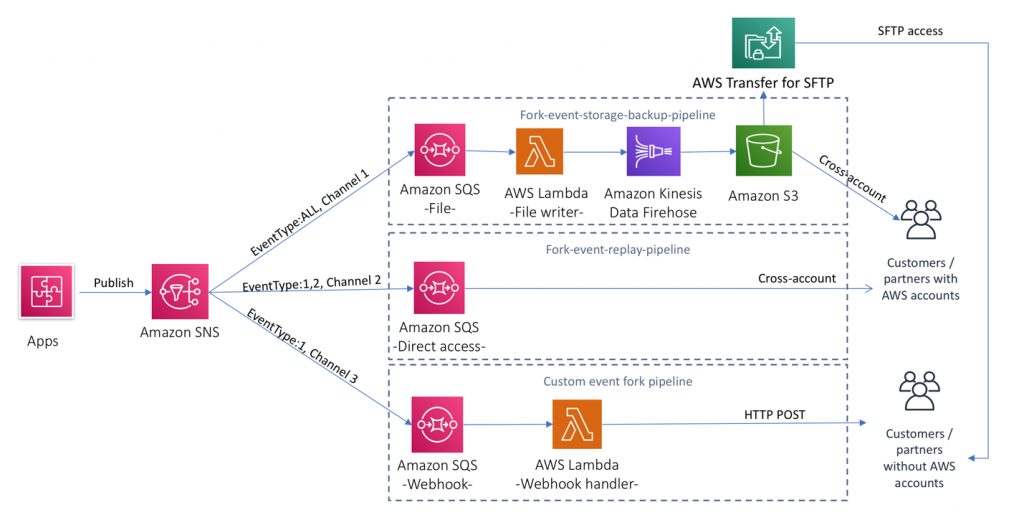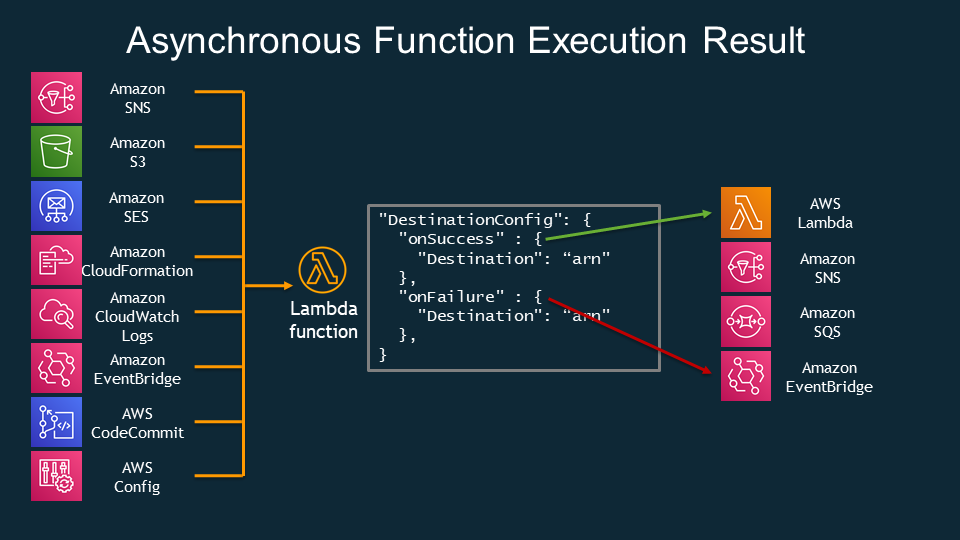AWS Compute Blog
Category: Messaging
Integrating B2B using event notifications with Amazon SNS
This post is courtesy of Murat Balkan, AWS Solutions Architect Event notification patterns are popular among B2B integrations. Their scalable and decoupled structure helps implement complex integration scenarios in a variety of enterprises. This post introduces a generic serverless architecture that applies to external integrations that use event notifications with Amazon SNS and Event Fork Pipelines. […]
ICYMI: Serverless pre:Invent 2019
With Contributions from Chris Munns – Sr Manager – Developer Advocacy – AWS Serverless The last two weeks have been a frenzy of AWS service and feature launches, building up to AWS re:Invent 2019. As there has been a lot announced we thought we’d ship an ICYMI post summarizing the serverless service specific features that […]
Introducing AWS Lambda Destinations
Today we’re announcing AWS Lambda Destinations for asynchronous invocations. This is a feature that provides visibility into Lambda function invocations and routes the execution results to AWS services, simplifying event-driven applications and reducing code complexity. Asynchronous invocations When a function is invoked asynchronously, Lambda sends the event to an internal queue. A separate process reads […]
Running Cost-effective queue workers with Amazon SQS and Amazon EC2 Spot Instances
This post is contributed by Ran Sheinberg | Sr. Solutions Architect, EC2 Spot & Chad Schmutzer | Principal Developer Advocate, EC2 Spot | Twitter: @schmutze Introduction Amazon Simple Queue Service (SQS) is used by customers to run decoupled workloads in the AWS Cloud as a best practice, in order to increase their applications’ resilience. You […]
New AWS Lambda controls for stream processing and asynchronous invocations
Today AWS Lambda is introducing new controls for asynchronous and stream processing invocations. These new features allow you to customize responses to Lambda function errors and build more resilient event-driven and stream-processing applications. Stream processing function invocations When processing data from event sources such as Amazon Kinesis Data Streams, and Amazon DynamoDB Streams, Lambda reads […]
Migrating from IBM MQ to Amazon MQ using a phased approach
This post is contributed by Mithun Mallick, Solutions Architect and Christian Mueller, Solutions Architect Message-oriented middleware (MOM), or message brokers, are the backbone that integrates business critical applications in many industries. MOMs are used to integrate systems like inventory management, payment systems, and CRM systems. They are also used to orchestrate order-processing workflows across multiple systems, […]
Application integration patterns for microservices: Fan-out strategies
This post is courtesy of Dirk Fröhner, Sr. Solutions Architect The first blog in this series introduced asynchronous messaging for building loosely coupled systems that can scale, operate, and evolve individually. It considered messaging as a communications model for microservices architectures. This post covers concrete architectural considerations, focusing on the messaging architecture. Part 3 covers running […]
Understanding asynchronous messaging for microservices
This post is courtesy of Dirk Fröhner, Sr. Solutions Architect One of the implications of applying the microservices architectural style is that much communication between components happens over the network. After all, your microservices landscape is a distributed system. To achieve the promises of microservices, such as being able to individually scale, operate, and evolve each service, this […]
New for AWS Lambda – SQS FIFO as an event source
AWS Lambda first announced support for Amazon SQS standard queues as an event source in April 2018. This allows builders to develop serverless applications using queues to directly invoke Lambda functions. Today, we have expanded this feature to include SQS FIFO queues. This makes it easier to create serverless applications using queues where the order […]
Designing durable serverless apps with DLQs for Amazon SNS, Amazon SQS, AWS Lambda
This post is courtesy of Otavio Ferreira, Sr Manager, SNS. In a postal system, a dead-letter office is a facility for processing undeliverable mail. In pub/sub messaging, a dead-letter queue (DLQ) is a queue to which messages published to a topic can be sent, in case those messages cannot be delivered to a subscribed endpoint. […]









